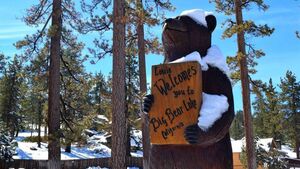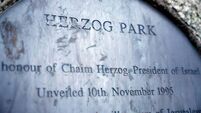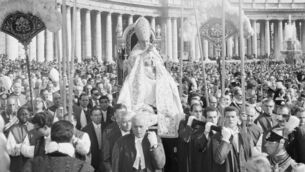Soulless Big Bear Lake and deliberate forgetting

Louie the wooden bear statue holding a 'Welcome to Big Bear Lake' sign at Boulder Bay Park.
During college, I spent two wonderful summers working as a tour guide at the Céide Fields Visitor Centre in Belderrig.
I realised early that the Office of Public Works (OPW) script they gave us - anaemic bullet points and vague timelines - accompanied by our damp, midge-infested mountain wasn’t going to capture the soul of this ancient site, or sell the story of “shtones in holes” (as some locals called our archaeological trenches) to tourists.
My fellow-conspirator Noel Kelly and I took it upon ourselves to rewrite the narrative into the ballads we wove on our guided tours as we traipsed up and down the boggy mountain behind the centre. We’d listened to the colourful stories of our hero Professor Seamas Caulfield (with Dr Noel Dunne), who excavated the site and were captivated not just by the facts, but by the deep time, the sense of presence and ancestry, the story of humanity.
So we made up our own versions, loosely based on the official OPW notes, but full of local folklore, community connection, jokes, stories and meaning. Mine always began with: “Five thousand years ago, Stone Age farmers first set foot on the island of Ireland and some ended up here, in what is now known as North Mayo.”
By the second summer I updated my talk to “five thousand and one years ago”, which led to one satire-deficient tourist praising my remarkable precision and my weary manager warning me (again) not to get too creative with the archaeology.
Shortly after, I believed I was going to be fired when I failed to dissuade two lovely American ladies - fired up with cultural appreciation but also very deaf - from enthusiastically praising their guide to Dr Dunne. They explained to the experienced archaeologist how tiny “Leprecians” constructed the extensive settlement of walls, tombs and houses “under the bog”. As they skittled away, he turned and winked at me, “Go easy on the leprechauns, Liam,” and I promised him I’d stick with the facts... mostly.
My Céide Fields experience instilled in me that landscape has memory and this has stayed with me. I believe culture is rooted in the generational story. Place matters. Tradition matters. History matters.
That’s what makes it so jarring, so alien, to travel in parts of the United States where the opposite is true - where cultural amnesia has been built into the landscape. Where memory has been paved over, commodified, or erased entirely.
Last month, my wife Kate and I made a trip into the mountains, to Big Bear Lake in California where Los Angeles residents enjoy the winter ski slopes or summer vacations in the woods around the lake. What we found there - among the charming wooden guesthouses, holiday homes and pine trees - was a textbook example of a beautiful place that had decided to forget itself entirely and exist instead as a superficial ode to modern consumerism.
We stayed at the Eagle’s Nest Lodge, a timber-framed building nestled among pines, run by two kind Chinese immigrants using translation apps on their phones. They were friendly, helpful, but as disconnected from the story of the area as anyone else.
“My name is China,” the man said with a gap-toothed grin and ordered us to visit the ski resort for some reason.
Outside, Big Bear Lake was teeming with middle-class families from L.A., escaping the city heat. Thousands of holiday homes dotted the hillsides. The ski slopes were barren in summer, but still served as backdrops for selfies. The town below was buzzing with activity - bars, restaurants, candy stores, gift shops - but it was a commercial buzz, not a cultural one.
I paid $11 for a glass of cider - much smaller than an Irish pint - and walked past expensive storefronts stuffed with bear-themed mugs, mass-produced coonskin caps, t-shirts and plastic snow globes. We could have been in a mall anywhere in the USA. Very little felt anchored to the place itself.
Not that you would know it from visiting Big Bear Lake, but the San Bernardino Mountains are the ancestral home of the Yuhaviatam (Serrano) people for millennia. These 'People of the Pines' lived in seasonal villages in the valley, subsisting on native plants, game and acorns, while holding grizzly bears with spiritual reverence rather than viewing them as food.
Big Bear’s name itself is born from violence. In 1845, a military expedition to suppress local Native American groups, led by rancher-politician Benjamin Davis Wilson, encountered dozens of grizzly bears in the area. He and his party killed many of them and Wilson bestowed the name 'Big Bear' after the massacre. Later trappers drove them to extinction. Today, that story is reduced to a stupidly-smiling cartoon bear on a storefront sign.
In 1866, as anti–Native American sentiment ran high, a month-long killing spree of the Serrano across the Big Bear area by a San Bernardino militia saw the remaining 20 to 30 people move from their mountain homelands to the San Bernardino Valley. Even the lake is mostly artificial. Created in 1885 by damming a valley to store water for settler farmers, it flooded Indigenous wetlands, altered local ecosystems and erased the seasonal rhythms of the remaining native peoples.
Not once during our visit did we see a real acknowledgment of the Indigenous people who lived - and still live - in the region. The San Manuel Band of Mission Indians, descendants of the Serrano, operate one of the most successful tribal enterprises in the United States, just a short drive away. But their presence is invisible in Big Bear.
There is no tribal museum. No visitor centre about ancestral land use. No exhibits about traditional plant medicine, fire management, or cosmology. A few shops sold generic, made-in-China 'Indian' memorabilia - raccoon-skin hats and plastic feathers - but this was kitsch, not culture.
Kate put it best: “It’s like a movie set. There’s no weight to anything."
Aside from the surprising number of overweight people. Children waddling in flip-flops, families grazing on sugary snacks, faces flushed and stomachs bulging over shorts and skirts - with the odd Ozempic-faced mom.
Both place and people here exist in a memory-free consumer 'now', stuffed with super-processed kitsch but internally malnourished. Cultural amnesia isn’t just a historical condition, it becomes a physical one in its eagerness to sell colourful, vapid 'stuff' to those addicted to fast food and fast fashion.
This isn’t an accident or oversight - forgetting makes space for development. For profit. For uncomplicated stories. A place like Big Bear Lake thrives by selling an illusion: wilderness without wildness, heritage without history and leisure without context. Even liberal California, for all its rhetoric of honouring diversity, seems more invested in selective remembering. A clean slate, in this context, is a wiped slate. One where land is property and real history is a liability.
In this amnesia, we lose not just Indigenous memory, but everyone’s. When the story of a place is flattened, we all become tourists, wandering heedlessly through someone else’s homeland, ignorant of where we step.
Big Bear could do better - and it’s not about guilt. It’s about depth. A tribal cultural centre. Interpretive trails. Bilingual signage. Meaningful partnerships with the native people. Real public art, rooted in memory. Eco-tourism that includes Indigenous ecological knowledge, not just ski lift passes. Giving visitors something more than bear ice-creams and slogan t-shirts. Restoring the soul of a place from authentic connection to the past.
Kate and I left Big Bear Lake with the sense that we had seen a beautiful place that had chosen to forget itself. And in doing so, it had lost something essential, something not even the pine trees or beautiful sunsets could restore. But cultural amnesia doesn’t just erase, it erodes. It leaves behind spiritually-empty towns, lost people and myth-selling souvenir shops.
We need instead a rebellious descendant of the Serrano to greet a group of puzzled tourists before leading them up a mountain trail, beginning with: “Thousands and one years ago, our peoples first set foot on the American continent and some ended up here, in what is now known as Big Bear Lake.”





